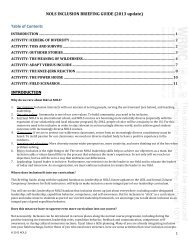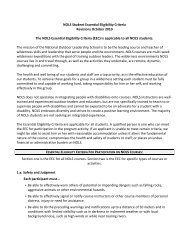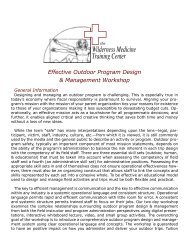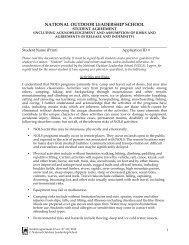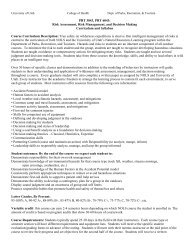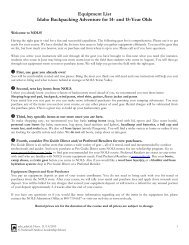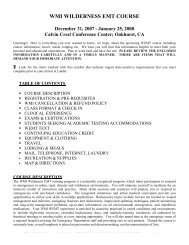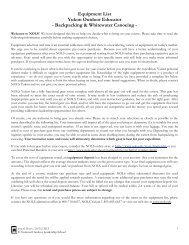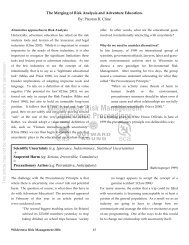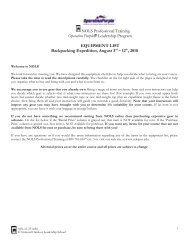LEADERSHIP THEORIES WEUSE TO TEACH LEADERSHIPThere are a variety of <strong>the</strong>ories instruc<strong>to</strong>rs can use <strong>to</strong> help teachelements of <strong>leadership</strong> <strong>to</strong> students. This section summarizes a few<strong>to</strong>ols you might want <strong>to</strong> try out.“Great” Leaders DiscussionBegin by having students name someone <strong>the</strong>y think is or was a“great” leader. (Hint – if you define “great” in <strong>the</strong> sense that <strong>the</strong>ywould like <strong>to</strong> be a leader like this person, or would want <strong>to</strong> be afollower of this person, students are less likely <strong>to</strong> pick Hitler-esqueexamples.)Ask students <strong>to</strong> brains<strong>to</strong>rm a list of traits of great leaders (samplelist provided below).Have students <strong>to</strong> identify two or three of <strong>the</strong>se traits <strong>the</strong>y think<strong>the</strong>y already have or are good at.Have students identify two traits <strong>the</strong>y want <strong>to</strong> work <strong>to</strong>wards over<strong>the</strong> next couple of days.Follow up with a group or individual check-ins a couple of dayslater <strong>to</strong> find out how students are doing on <strong>the</strong>ir goals.Sample list of traitssense of humor playful open-heartedpersistent courageous flexibleintelligent optimistic skilledself-confident visionary honestshows integrity respectful <strong>to</strong>leran<strong>to</strong>rganized empa<strong>the</strong>tic adaptableIdentify a Variety of Leadership StylesDifferent <strong>leadership</strong> styles are effective under different conditions.Authoritarian styles may be effective for task accomplishment,but <strong>the</strong>y may also encourage dependency of <strong>the</strong> group over time.Democratic <strong>leadership</strong> can become pseudo-collaborative ra<strong>the</strong>r thanactually collaborative <strong>leadership</strong> if it gives strength only <strong>to</strong> <strong>the</strong> oneswho speak up—i.e. extremists. Laissez-faire <strong>leadership</strong> works in certainsituations, but a leaderless crowd is also <strong>the</strong> most likely <strong>to</strong> panicif something goes wrong. The preferred <strong>leadership</strong> style is highlyinfluenced by culture.We need <strong>to</strong> encourage people <strong>to</strong> develop a variety of differentstyles. Effective leaders exhibit versatility and flexibility that enable<strong>the</strong>m <strong>to</strong> adapt <strong>the</strong>ir behavior <strong>to</strong> every situation. Encourage your students<strong>to</strong> think about and discuss <strong>the</strong> situational appropriateness ofvarious styles. This discussion fits well in hiking/travel group debriefs.Teaching Situational LeadershipSituational <strong>leadership</strong> is a set of strategies that allows individuals<strong>to</strong> lead successfully by varying <strong>the</strong>ir behavior from one situation <strong>to</strong><strong>the</strong> next, so as <strong>to</strong> provide appropriate <strong>leadership</strong> actions at appropriatetimes (Hersey, 1993). Leadership is specific <strong>to</strong> a particular groupin a particular situation, and behaviors that work wonders in onegroup or situation may fail miserably in ano<strong>the</strong>r. It’s complex.highsupportive behavior(relationship)lowlowSituational Leadership(adapted from Blanchard, 1999)DelegatingSupportingCoachingdirective behavior (task)DirectinghighIdeas for Teaching Situational LeadershipReview <strong>the</strong> above progression of situational <strong>leadership</strong> with yourgroup. Ask students <strong>to</strong> identify what type of <strong>leadership</strong> <strong>the</strong>y think<strong>the</strong>ir group currently needs most.Have <strong>the</strong> students discuss what <strong>the</strong> role of <strong>the</strong> student is in thisstage, and what <strong>the</strong> role of <strong>the</strong> instruc<strong>to</strong>r should be.Discuss what kinds of information, opportunities, coaching, etc.<strong>the</strong> students need and can expect from you as instruc<strong>to</strong>rs at thispoint in <strong>the</strong> course.A new group (or an existing group with a new task) needs directive<strong>leadership</strong> and less in-depth, two-way dialogue. The leader tells<strong>the</strong> group members what <strong>the</strong>y have <strong>to</strong> do and defines everyone’sroles. The first few days of a NOLS course are like this, when studentsare novices. Key <strong>leadership</strong> actions include directing, establishing,structuring, and guiding. Role-modeling and letting peopleknow what is expected of <strong>the</strong>m is critical at this stage.After <strong>the</strong> group has settled in and has a basic idea of what everyoneis supposed <strong>to</strong> be doing, a group needs a different type of <strong>leadership</strong>.Group members are still unable <strong>to</strong> do many things on <strong>the</strong>irown, but <strong>the</strong>y’re trying. It is important <strong>to</strong> support <strong>the</strong>ir motivationand commitment <strong>to</strong> tackle <strong>the</strong> tasks. This is often called <strong>the</strong> coachingstage. Group members still need a lot of direction and instruction,but <strong>the</strong>y also need <strong>to</strong> understand what <strong>the</strong> leader is trying <strong>to</strong>achieve in <strong>the</strong> long run. This means that leaders must clarify <strong>the</strong>irreasoning and ask for <strong>the</strong> group’s input.On a course, this stage may be when you start practicing Leaderof <strong>the</strong> Day, or LOD. You are teaching students, encouraging <strong>the</strong>mand correcting <strong>the</strong>m, while also listening <strong>to</strong> <strong>the</strong>ir experience, reactionsand desires. Key <strong>leadership</strong> actions here are explaining, listening,clarifying, correcting and reinforcing.As group members become more comfortable with <strong>the</strong>ir skillsand each o<strong>the</strong>r, <strong>the</strong>ir readiness <strong>to</strong> take on responsibility usually increases.However, <strong>the</strong>y’ve just developed <strong>the</strong>ir ability and haven’t hadan opportunity <strong>to</strong> gain confidence working on <strong>the</strong>ir own. O<strong>the</strong>rtimes, <strong>the</strong>y are not motivated <strong>to</strong> do a task on <strong>the</strong>ir own. In thisstage, called supporting, key <strong>leadership</strong> actions are discussing, collaborating,participating, encouraging, and facilitating. The leadersteps way back in telling <strong>the</strong> group what <strong>to</strong> do and how <strong>to</strong> do it. Theleader needs <strong>to</strong> set up a structure that encourages <strong>the</strong> group <strong>to</strong> takeDefining Leadership 12<strong>2008</strong> NOLS Leadership Educa<strong>to</strong>r Notebook
some risks, succeed a bit, and maybe fail some or at least stretch abit. However, <strong>the</strong> leader can’t step back from supporting <strong>the</strong> group.NOLS students in this stage need a lot of active listening, feedback,coaching and help with <strong>to</strong>ugh spots. They don’t need you <strong>to</strong>do <strong>the</strong>ir work for <strong>the</strong>m. On a course, this is when students are leadingmost aspects of travel days.The final stage, delegating, takes place when <strong>the</strong> group membersare both ready and willing <strong>to</strong> do <strong>the</strong> task. They are ready and confident.They’ve had enough opportunity <strong>to</strong> practice and <strong>the</strong>y feelcomfortable without <strong>the</strong> leader providing direction. This is where<strong>the</strong> leader gives <strong>the</strong>m <strong>the</strong> ball and lets <strong>the</strong>m run with it. The leadermust grant group members considerable independence regardinghow <strong>the</strong>y do <strong>the</strong>ir tasks and how <strong>the</strong>y organize <strong>the</strong>mselves asa group. The leader must step back from directing and decidingthings for <strong>the</strong> group, except in very specific circumstances, so as<strong>to</strong> respect <strong>the</strong> group’s au<strong>to</strong>nomy. Still, observing and moni<strong>to</strong>ringare important <strong>leadership</strong> activities. The leader must keep a pulse onwhat’s going on.This includes NOLS’s Independent Student Group Expedition,or when students run a ration period, or any time instruc<strong>to</strong>rs are lettingstudents run <strong>the</strong> show. You are more or less an observant guest,who doesn’t step in unless parameters have been crossed (i.e. safety)or <strong>the</strong> group meets a situation <strong>the</strong>y are not yet ready <strong>to</strong> deal with.If this is what we actually do with students, should we also try <strong>to</strong>teach our students how <strong>to</strong> do this with <strong>the</strong>ir peers? Explaining <strong>the</strong><strong>the</strong>ory may be useful <strong>to</strong> <strong>the</strong>m later on, especially when <strong>the</strong>y go homeand start leading friends and family. They don’t need <strong>to</strong> verbalize <strong>the</strong>stages <strong>to</strong> <strong>the</strong>ir friends—but keeping <strong>the</strong> <strong>the</strong>ory in mind may help<strong>the</strong>m <strong>to</strong> figure out when <strong>the</strong>y should be giving more help and directionand when <strong>the</strong>y can give less.Ideas for Teaching About PowerHave your students brains<strong>to</strong>rm a list of different ways that a personhas or can get power on a NOLS course (e.g. designated leaderof <strong>the</strong> day, lots of experience, very loud voice, etc.)Ask your students <strong>to</strong> discuss how people lose power (being bossy,pretending <strong>to</strong> know things that <strong>the</strong>y don’t, etc.)Allow your students <strong>to</strong> think for <strong>the</strong>mselves and articulate how<strong>the</strong>y hope <strong>to</strong> gain and use power throughout <strong>the</strong> course.Power and LeadershipDifferent types of power work best with different styles of <strong>leadership</strong>.Here are some examples of different types of power held byleaders:Expert power: <strong>the</strong> perceived extent of relevant knowledge and skillof a personReferent (greatness) power: <strong>the</strong> extent <strong>to</strong> which o<strong>the</strong>rs want <strong>to</strong> beclose <strong>to</strong> a personAuthorized (legitimate) power: <strong>the</strong> right of a person <strong>to</strong> be influentialgiven <strong>the</strong>ir positionReward power: <strong>the</strong> extent <strong>to</strong> which a person is viewed as having <strong>the</strong>ability <strong>to</strong> give rewardsCoercive power: <strong>the</strong> extent <strong>to</strong> which a person is viewed as being able<strong>to</strong> punish o<strong>the</strong>rsInformational power: <strong>the</strong> amount of insider information a personhas about <strong>the</strong> his<strong>to</strong>ry, culture and cus<strong>to</strong>ms of a groupConnection power: <strong>the</strong> number of close relationships a person haswith o<strong>the</strong>r key members of a groupThe most influential leaders were seen as those having expert, referent,informational and connection power. The least effective powersfor influencing o<strong>the</strong>rs were found <strong>to</strong> be authorized, reward andcoercive power, although <strong>the</strong>se were not unimportant. This studyalso demonstrated that <strong>to</strong> be an influential leader over time, sharingpower and influence with <strong>the</strong> group are vital. It also says that powerstruggles can erupt when a group member has more referent andconnective power with <strong>the</strong> group than <strong>the</strong> authorized leader. I thinkwe have all seen this happen in peer <strong>leadership</strong> on courses.Teaching Leadership through Authority:Designated LeadershipThe <strong>the</strong>ory of designated <strong>leadership</strong> can be viewed as a subset ofauthorized power. Some even believe that just putting someone ina <strong>leadership</strong> role can help <strong>the</strong>m <strong>to</strong> become a good leader. Studentswho are “Leader Of <strong>the</strong> Day” are leaders by virtue of that title, <strong>the</strong>tasks that we authorize, and <strong>the</strong>ir level of accountability. NOLScourse leaders are designated leaders. The NOLS executive direc<strong>to</strong>ris a designated leader. These people have legitimate power given <strong>to</strong><strong>the</strong>m and thus also have great responsibility. See <strong>the</strong> “Leaders of TheDay” section in this book for teaching suggestions.Transformational/Visionary LeadershipTransformational leaders project a vision, motivate and inspirefollowers, engage followers in actively seeking new solutions <strong>to</strong> oldproblems and seek <strong>to</strong> raise aspiration levels among followers (Deluga,1992). Teaching notes for this <strong>to</strong>pic can be found on page 55.If a student is fortunate enough <strong>to</strong> arrive at NOLS with <strong>the</strong> characteristicsof a transformational leader, <strong>the</strong> best gift we can give heror him may be support in seeking greater self-knowledge and encouragement<strong>to</strong> use <strong>the</strong>ir skills wisely. We should also support <strong>the</strong>student in using collaborative <strong>leadership</strong> <strong>to</strong>ols so <strong>the</strong>y help createmany leaders in <strong>the</strong> group. But with beginning outdoor <strong>leadership</strong>students, visionary transformational <strong>leadership</strong> seems an impracticalgoal for <strong>the</strong> average individual. Many people do use it as a vision ina transference discussion.StewardshipOn a NOLS course, stewardship means downplaying pointsource<strong>leadership</strong>. The whole group discusses and agrees on what<strong>leadership</strong> will look like and how everyone will support <strong>leadership</strong>as a group. The student leader’s goal is <strong>to</strong> not only <strong>to</strong> get <strong>the</strong> groupfrom place <strong>to</strong> place, but <strong>to</strong> also make sure everyone has an opportunity<strong>to</strong> learn and grow.Class SuggestionsStewardship can be taught as followership or through classes onexpedition behavior.In stewardship, <strong>leadership</strong> does not emanate from a point source.Instead, it is part of everyone involved. Designing an environmentthat encourages learning and <strong>leadership</strong> in everyone is <strong>the</strong> primarytask of a steward. Personal responsibility, personal accountabilityand self-awareness are <strong>the</strong> keys<strong>to</strong>nes of this model.How does stewardship look at NOLS? The instruc<strong>to</strong>rs are akin <strong>to</strong><strong>the</strong> architects of a ship, not captains. Every student and instruc<strong>to</strong>r isresponsible for designing <strong>the</strong> course through discussion. The groupworks <strong>to</strong>ge<strong>the</strong>r <strong>to</strong> figure out how and what <strong>the</strong>y will be. A certainamount of chaos is inevitable in this model. Students and instruc<strong>to</strong>rsfeel accountable for <strong>the</strong> success or failure of any venture. The philosophyis: “People learn what <strong>the</strong>y need <strong>to</strong> learn, not what I may think<strong>the</strong>y need <strong>to</strong> learn.” (Block, 1993) Students take responsibility for<strong>the</strong>ir evaluation and growth in<strong>to</strong> <strong>the</strong>ir own hands. There is a strivingfor absolute honesty at all levels and <strong>the</strong> truth is not avoided for social<strong>2008</strong> NOLS Leadership Educa<strong>to</strong>r Notebook 13Defining Leadership




